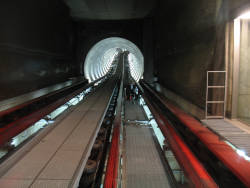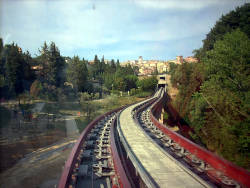Minimetrò Perugia
Perugia People Mover
Useful Information


| Location: |
Perugia.
(43.110044, 12.382091) |
| Open: |
All year Mon-Sat 7-21:05, Sun 9-20:45. [2022] |
| Fee: |
Single Race UP EUR 1.50, 10 Multi-trips UP EUR 12.90, Tourist 1 day UP EUR 5.40. [2022] |
| Classification: |
 Underground Railway Underground Railway
|
| Light: |
 Incandescent Incandescent
|
| Dimension: | |
| Guided tours: | self guided |
| Photography: | allowed |
| Accessibility: | yes |
| Bibliography: | |
| Address: |
Minimetrò Spa, Piazza Umbria Jazz, 1, 06125 Perugia, Tel: +39-075-5058753.
E-mail: Headquarter Leitner Vipiteno (I), Via Brennero 34, IT-39049 Vipiteno, Tel: +39-0472-722111. E-mail: |
| As far as we know this information was accurate when it was published (see years in brackets), but may have changed since then. Please check rates and details directly with the companies in question if you need more recent info. |
|
History
| 1998 | Minimetrò SpA, a public/private company with mixed capital, established. |
| 2008 | first MiniMetro in the world opened to the public. |
Description






The Minimetrò (Minimetro) is a sort of metro, subway, underground, but based on a completely different technology. Actually MiniMetro® is the name given by its inventor, the cable car company Leitner AG (HTI Group) from Sterzing (Vipiteno). Sterzing is located in the middle of the Alps, at the foot of the Brenner Pass.
This is a cable-drawn urban rail transportation systems and belongs to the cable propelled automated people mover systems. In other words this is a modern cable car system which runs on rails instead of hanging on a cable. Normal subways have rails, and the trains have electric engines which move them. This system has carts without engine, which are pulled by a cable. The cable moves all the time, but the carts can stop by opening the detachable grip, so it is not pulled any more. If the grip is closed again it is pulled again. Such cable cars already exist in many skiing areas, the cabin even leaves the main rope and is pulled by a second much slower rope to give the passengers more time to leave and board the cabin. Skiing is still the same, but getting on the mountain has become much more comfortable in the last 20 years.
The system rather new, because it allows to add and remove carts from the rope depending on demand. It also allows carts to stop at stations while people enter and leave the cart while the main cable still pulls all the other carts. The system is rather easy to automate and drivers are not required. Less technology in the cart means they are far cheaper, it’s affordable to have more additional carts for peak times. It is possible to be very flexible concerning the amount of people, by just increasing the amount of carts on the rope with no additional drivers needed. The current maximum capacity of the system is around 8,000 passengers per hour, it is used by about 10,000 passenger per day, which is quite a lot for a town the size of Perugia. The system is very interesting for cities which need smaller subway systems and want to reduce the cost of a subway system.
The company has a prototype at Sterzing, where they are located. And there are at least half a dozen installations worldwide, most of them above ground. But the Perugia People Mover is partly underground, right across the historic town center, which actually makes no difference for the technology. There are a 4 km of rails, seven stations, and 25 vehicles which are 5 m long and have a capacity of 25 persons each. The speed is 20 km/h and the minimum interval between successive vehicles only 1.5 minutes.
Using cable based public transport in cities is not new. Funiculars were built all over the world since the 19th century. And there are numerous cities which are famous for their cable car systems. But a cable based system which could replace subways is rather new. While it is not a silver bullet, there are obviously good reasons to install such a system under certain circumstances.
The visit is simple, the public transport is open every day, just buy a ticket at the teller machine and start your journey.
We strongly recommend the day ticket, as a tourist you will probably drive from one spot to the next, and it’s much cheaper than single tickets.
And also the validation is much easier.
They have a sort of tourist route planner on their website, which will give you a list of all sights along the route.
And one last comments: the escalators typically run until midnight, while the trains stop at 21.
The reason is simply that they are also the access to the underground city, the
 Rocca Paolina.
The tunnels are used as underground footways to quickly reach a different part of the city.
Rocca Paolina.
The tunnels are used as underground footways to quickly reach a different part of the city.
 Search DuckDuckGo for "Minimetrò Perugia"
Search DuckDuckGo for "Minimetrò Perugia" Google Earth Placemark
Google Earth Placemark MiniMetro - Wikipedia (visited: 25-MAY-2022)
MiniMetro - Wikipedia (visited: 25-MAY-2022) Minimetrò S.p.A., official website
Minimetrò S.p.A., official website  (visited: 25-MAY-2022)
(visited: 25-MAY-2022) Index
Index Topics
Topics Hierarchical
Hierarchical Countries
Countries Maps
Maps